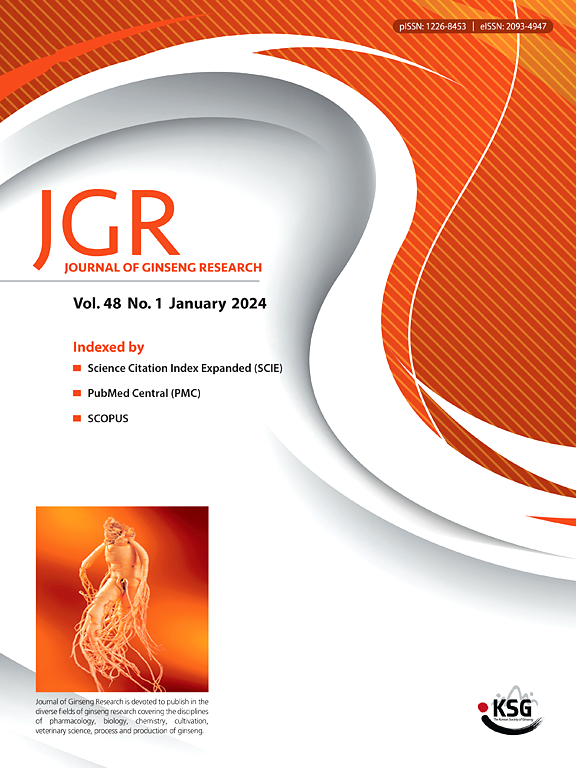Panax ginseng exerts cardioprotective effect post myocardial infarction by attenuating myocardial fibrosis and inflammation through SIRT1 signaling pathways
IF 6.8
2区 医学
Q1 CHEMISTRY, MEDICINAL
引用次数: 0
Abstract
Background
Myocardial fibrosis and inflammation induce adverse cardiac remodeling post-myocardial infarction (MI). Panax ginseng (P. ginseng) is beneficial for diverse cardiovascular diseases. However, the therapeutic effect and molecular mechanism underlying cardiac remodeling are largely unclear.
Methods
A MI mouse model was constructed through permanent left anterior descending (LAD) coronary artery ligation. Transforming growth factor-β1 (TGF-β1) or lipopolysaccharide (LPS) was used for stimulating cardiac fibroblasts (CFs) or RAW264.7 macrophages to construct the collagen synthesis and inflammation model in vitro. The cardiac structure and function were detected through hematoxylin-eosin staining, Masson staining, and echocardiography, while myocardial fibrosis and inflammation markers were determined by Western-blot, immunohistochemistry, RT-PCR, and ELISA. Additionally, the Silent information regulator 1 (SIRT1)/nuclear factor-κB (NF-κB) mediated NOD like receptor 3 (NLRP3) inflammasome and TGF-β receptor I (TGFBR1) signaling pathways were also evaluated. A SIRT1 selective inhibitor (EX-527) was used for confirming the pharmacological mechanism of P. ginseng.
Results
In vivo, P. ginseng alleviated ventricular remodeling, enhanced heart function, and ameliorated collagen I, collagen III, IL-1β, and IL-18 levels dose-dependently. Moreover, P. ginseng significantly suppressed NLRP3-caspase1 inflammasome and TGFBR1/Smads signaling in MI mice. In vitro, P. ginseng significantly suppressed collagen and inflammation markers, NLRP3 inflammasome and TGFBR1/Smads signaling in TGF-β1-induced CFs or LPS-stimulated RAW264.7 cells. Mechanistically, P. ginseng suppressed NF-κB activity while promoting SIRT1 expression. SIRT1 suppression by EX-527 partially abolished the protective effects of P. ginseng in TGF-β1-induced CFs.
Conclusion
P. ginseng protects from adverse cardiac remodeling by attenuating myocardial fibrosis and inflammation post-MI through the regulation of SIRT1 and its downstream signaling pathways.

人参通过SIRT1信号通路减轻心肌纤维化和炎症,发挥心肌梗死后心肌保护作用
心肌纤维化和炎症可诱导心肌梗死(MI)后不良的心脏重构。人参对多种心血管疾病有益。然而,心脏重构的治疗效果和分子机制在很大程度上尚不清楚。方法采用冠状动脉永久性左前降支结扎法建立心肌梗死小鼠模型。采用转化生长因子-β1 (TGF-β1)或脂多糖(LPS)刺激心肌成纤维细胞(CFs)或RAW264.7巨噬细胞构建体外胶原合成及炎症模型。采用苏木精-伊红染色、Masson染色、超声心动图检测心肌结构和功能,采用Western-blot、免疫组织化学、RT-PCR、ELISA检测心肌纤维化和炎症标志物。此外,沉默信息调节因子1 (SIRT1)/核因子-κB (NF-κB)介导的NOD样受体3 (NLRP3)炎性体和TGF-β受体1 (TGFBR1)信号通路也被评估。采用SIRT1选择性抑制剂EX-527对人参的药理机制进行了研究。结果在体内,人参可减轻心室重构,增强心功能,改善I型胶原、III型胶原、IL-1β和IL-18水平,呈剂量依赖性。此外,人参显著抑制心肌梗死小鼠NLRP3-caspase1炎性体和TGFBR1/Smads信号通路。在体外,人参显著抑制TGF-β1诱导的CFs或lps刺激的RAW264.7细胞中的胶原和炎症标志物、NLRP3炎性体和TGFBR1/Smads信号。机制上,人参抑制NF-κB活性,促进SIRT1表达。EX-527抑制SIRT1部分消除了人参对TGF-β1诱导的cfs的保护作用。人参通过调节SIRT1及其下游信号通路,减轻心肌梗死后心肌纤维化和炎症,从而保护心肌免受不良重构。
本文章由计算机程序翻译,如有差异,请以英文原文为准。
求助全文
约1分钟内获得全文
求助全文
来源期刊

Journal of Ginseng Research
CHEMISTRY, MEDICINAL-INTEGRATIVE & COMPLEMENTARY MEDICINE
CiteScore
11.40
自引率
9.50%
发文量
111
审稿时长
6-12 weeks
期刊介绍:
Journal of Ginseng Research (JGR) is an official, open access journal of the Korean Society of Ginseng and is the only international journal publishing scholarly reports on ginseng research in the world. The journal is a bimonthly peer-reviewed publication featuring high-quality studies related to basic, pre-clinical, and clinical researches on ginseng to reflect recent progresses in ginseng research.
JGR publishes papers, either experimental or theoretical, that advance our understanding of ginseng science, including plant sciences, biology, chemistry, pharmacology, toxicology, pharmacokinetics, veterinary medicine, biochemistry, manufacture, and clinical study of ginseng since 1976. It also includes the new paradigm of integrative research, covering alternative medicinal approaches. Article types considered for publication include review articles, original research articles, and brief reports.
JGR helps researchers to understand mechanisms for traditional efficacy of ginseng and to put their clinical evidence together. It provides balanced information on basic science and clinical applications to researchers, manufacturers, practitioners, teachers, scholars, and medical doctors.
 求助内容:
求助内容: 应助结果提醒方式:
应助结果提醒方式:


